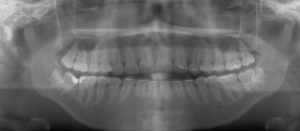
RADIOGRAPHS (X-RAYS)
All our x-rays at M Dental are digital, ensuring less radiation. We have both intra-oral and extra-oral x-rays for your convenience. These enable us to detect problems not visible clinically.
INTRA-ORAL X-RAY
This type of radiograph (x-ray) creates a close up of a single tooth; this enables the dentist to see cavities not easily visible to the naked eye.

PANORAMIC X-RAY/ EXTRA-ORAL X-RAY
This produces an image of both upper and lower teeth as well as the jaw, all in the one scan. This is very useful in more complex cases to determine a proper diagnosis and treatment plan.

For more information about care after oral surgery, visit Healthy Smiles.
Digital radiography provides our practice with a diverse range of image enhancing techniques. With this technology, we are able to manipulate the images to increase the clarity of our x-rays, and therefore exposing oral problems that would otherwise go undetected, thus aiding diagnosis and providing easier patient communication. It allows our staff to process high volumes of images quickly, effortlessly and producing higher quality radiographs than that of analog x-rays. Also, the time taken to process an image is just a few seconds, as compared to a traditional processing system.
Digital radiation allows us to acquire high quality x-rays with 80 – 90% less radiation than traditional x-ray. This reduces the amount of radiation exposure and creates a safer environment for our patients. Not only is this system beneficial to your health, but it is also environmentally friendly. Unlike traditional x-rays, digital x-rays do not require hazardous developing solutions or lead covered films, which end up polluting the environment. We are proud to eliminate a major source of environmental waste in the dental office; the lead from the film packets. We are constantly striving to reduce our footprint and optimise our patient care.
WHY WE TAKE X-RAYS
Here's Why:
- Look for Decay Between Teeth: Sometimes it's not visible to the naked eye.
- Check for Bone Loss: An xray will show the degree of bone loss associated with bone loss.
- Check for Decay Under Fillings: An xray is the only way to see this type of decay.
- Look for Infection at the Tip of the Root: If you have an infection near the bone, an xray will confirm this.
- Examine the Area Before Procedures: Gives dentists a full view of teeth and bones.
